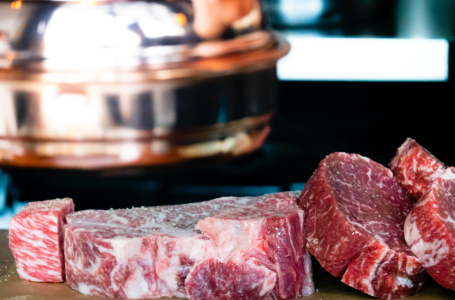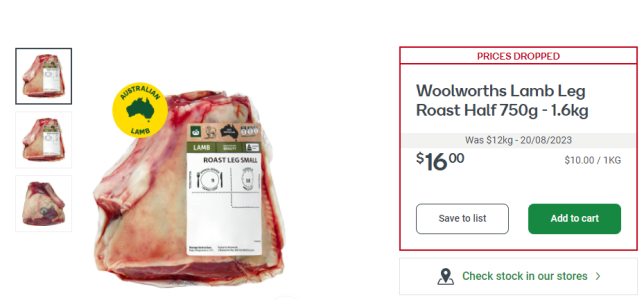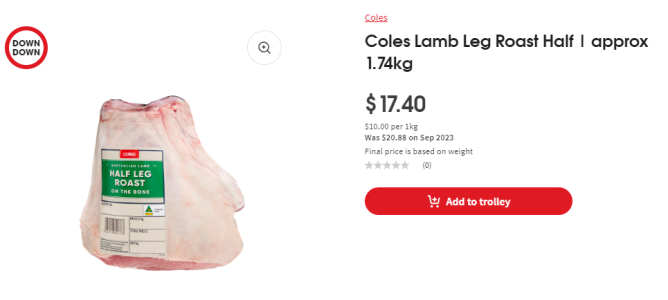Meat prices are getting cheaper, but at what cost to farmers?
As everyone prepares to fire up their barbecues for the summer, expect to be greeted with a pleasant surprise: meat prices are finally starting to come down after years of rises.
But behind the scenes, the turn of events dealing with this price relief has dealt a devastating blow to farmers.
Retail figures from Nielsen IQ suggested that meats like lamb cutlets, beef steaks and leg of lamb prices are now cheaper everywhere.
This is great news for barbeque lovers, as lamb cutlets are down 5 per cent, and demands are now rising for beef steaks, with its prices now 10 per cent cheaper.
But the biggest price drop can be seen in the leg of lamb, with its price point 13.5 per cent lower compared to last year.
Unfortunately, beef and lamb sausage prices are barely affected by the price drop.
However, farmers claim that it should have happened earlier, with some stating that the collapse in retail prices in supermarkets is modest compared to the livestock prices downturn farmers have been experiencing in the last 12 months.
Based on key indicators for the saleyards across Australia, lamb prices are down 37 per cent, and cattle have fallen 65 per cent yearly.
According to Andrew Dunlop, a farmer who runs cattle on Bungardby on the Monaro, the gap between the retail and saleyard prices should be investigated.
‘The failure of retail prices to come back is compounding the current oversupply, which is turning an orderly correction into what could be a train wreck,’ he said.
Over the past few years, the drought has caused a lower supply of livestock and caused saleyard prices to hit record levels. When it ended, supply rose, and the prices in saleyards began to fall.
And now, as the El Niño weather starts, farmers are selling their stock to avoid being caught without feed for them.
Due to this, Graham Anderson, a Dubbo stock and station agent, urged supermarkets to cut their prices to help raise demand for meat.
‘We want people to eat more meat, and I think that would be very good for the health of the industry,’ he said.
Meanwhile, a Woolworths spokesperson stated that they’re reducing the prices: ‘We have reduced the price of 45 different red meat products to help our customers' budgets go further, including our lamb leg roast, which is now $10 per kilo, the lowest price since 2018.’
The retailer cited an increase in meat processing costs—like labour, transport, electricity and packaging—as the reason for high prices.
Supermarkets also revealed that they have contracts with some farmers for their direct meat supply, locking prices for the long term.
‘We partner directly with our suppliers to agree on fair livestock prices that reflect market dynamics, as well as the high quality of their lamb,’ the spokesperson added.
On the Woolworths website, it was shown that Lamb Legs are down only $10/kilo from $12/kilo.
On the other hand, Coles claimed they’re focusing on supplying items at the best prices for customers.
A spokesperson for the retailer shared: ‘We know cost of living is the number one focus for our customers right now, and we continue to invest in providing value in our stores and online.’
They also said that meat specials are being changed every week. As of writing, a kilo of Lamb Leg at Coles costs $10/kilo.
This comes after the report that lamb prices have been falling in farms across Australia, but there is a lag before these price changes are seen in supermarkets. Industry body Meat and Livestock Australia anticipates that it could take up to eight months for consumers to see the full effect of the price slump.
You can read more about that story here.
Some farmers have taken it upon themselves to adjust to the saleyard prices. Independent butchers like Matt Halsall in Bordertown, South Australia, shared that there are farmers who would rather eat their meat than send it to saleyards, where it would only fetch $10/head.
‘They see it as more viable to fill their own freezers than it is to try and sell them at the markets,’ he said.
On the opposite side of the coin, Jason Morley, a farmer from outside Geurie in Central West New South Wales, is optimistic about the situation.
‘Compared to last year, our prices are probably half, but in the current conditions, it could be a lot worse,’ he said. ‘Farming is a game of ups and downs. You just have to ride the highs and bunker down with the lows and just keep on going.’

Have you noticed this trend in your local supermarkets? Let us know in the comments below!
But behind the scenes, the turn of events dealing with this price relief has dealt a devastating blow to farmers.
Retail figures from Nielsen IQ suggested that meats like lamb cutlets, beef steaks and leg of lamb prices are now cheaper everywhere.
This is great news for barbeque lovers, as lamb cutlets are down 5 per cent, and demands are now rising for beef steaks, with its prices now 10 per cent cheaper.
But the biggest price drop can be seen in the leg of lamb, with its price point 13.5 per cent lower compared to last year.
Unfortunately, beef and lamb sausage prices are barely affected by the price drop.
However, farmers claim that it should have happened earlier, with some stating that the collapse in retail prices in supermarkets is modest compared to the livestock prices downturn farmers have been experiencing in the last 12 months.
Based on key indicators for the saleyards across Australia, lamb prices are down 37 per cent, and cattle have fallen 65 per cent yearly.
According to Andrew Dunlop, a farmer who runs cattle on Bungardby on the Monaro, the gap between the retail and saleyard prices should be investigated.
‘The failure of retail prices to come back is compounding the current oversupply, which is turning an orderly correction into what could be a train wreck,’ he said.
Over the past few years, the drought has caused a lower supply of livestock and caused saleyard prices to hit record levels. When it ended, supply rose, and the prices in saleyards began to fall.
And now, as the El Niño weather starts, farmers are selling their stock to avoid being caught without feed for them.
Due to this, Graham Anderson, a Dubbo stock and station agent, urged supermarkets to cut their prices to help raise demand for meat.
‘We want people to eat more meat, and I think that would be very good for the health of the industry,’ he said.
Meanwhile, a Woolworths spokesperson stated that they’re reducing the prices: ‘We have reduced the price of 45 different red meat products to help our customers' budgets go further, including our lamb leg roast, which is now $10 per kilo, the lowest price since 2018.’
The retailer cited an increase in meat processing costs—like labour, transport, electricity and packaging—as the reason for high prices.
Supermarkets also revealed that they have contracts with some farmers for their direct meat supply, locking prices for the long term.
‘We partner directly with our suppliers to agree on fair livestock prices that reflect market dynamics, as well as the high quality of their lamb,’ the spokesperson added.
On the Woolworths website, it was shown that Lamb Legs are down only $10/kilo from $12/kilo.
On the other hand, Coles claimed they’re focusing on supplying items at the best prices for customers.
A spokesperson for the retailer shared: ‘We know cost of living is the number one focus for our customers right now, and we continue to invest in providing value in our stores and online.’
They also said that meat specials are being changed every week. As of writing, a kilo of Lamb Leg at Coles costs $10/kilo.
This comes after the report that lamb prices have been falling in farms across Australia, but there is a lag before these price changes are seen in supermarkets. Industry body Meat and Livestock Australia anticipates that it could take up to eight months for consumers to see the full effect of the price slump.
You can read more about that story here.
Some farmers have taken it upon themselves to adjust to the saleyard prices. Independent butchers like Matt Halsall in Bordertown, South Australia, shared that there are farmers who would rather eat their meat than send it to saleyards, where it would only fetch $10/head.
‘They see it as more viable to fill their own freezers than it is to try and sell them at the markets,’ he said.
On the opposite side of the coin, Jason Morley, a farmer from outside Geurie in Central West New South Wales, is optimistic about the situation.
‘Compared to last year, our prices are probably half, but in the current conditions, it could be a lot worse,’ he said. ‘Farming is a game of ups and downs. You just have to ride the highs and bunker down with the lows and just keep on going.’
Key Takeaways
- The price of meat is finally starting to drop as summer approaches in Australia, with beef steaks being about 10 per cent cheaper, lamb cutlets are now 5 per cent cheaper and leg of lamb prices have fallen 13.5 per cent.
- Farmers are frustrated that the fall in retail prices has not matched the dramatic decrease in livestock prices, with lamb prices down 37 per cent and cattle prices down 65 per cent compared to the previous year.
- As the El Niño weather emerges, leading to drier conditions, farmers are selling off their livestock to avoid a lack of feed.
- Supermarkets have been urged to further reduce their prices to stimulate demand, with Woolworths and Coles both stating they are focusing on providing value for their customers.
Have you noticed this trend in your local supermarkets? Let us know in the comments below!










